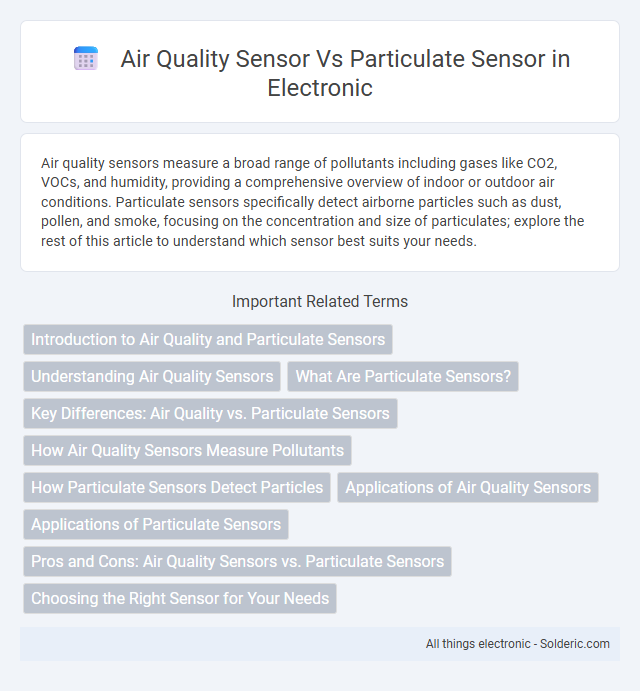Air quality sensors measure a broad range of pollutants including gases like CO2, VOCs, and humidity, providing a comprehensive overview of indoor or outdoor air conditions. Particulate sensors specifically detect airborne particles such as dust, pollen, and smoke, focusing on the concentration and size of particulates; explore the rest of this article to understand which sensor best suits your needs.
Comparison Table
| Feature | Air Quality Sensor | Particulate Sensor |
|---|---|---|
| Detection Scope | Multiple gases (CO2, VOCs, CO, NO2) | Particulate Matter (PM1.0, PM2.5, PM10) |
| Primary Use | Indoor air quality monitoring | Measuring fine dust & airborne particles |
| Output Data Type | Gas concentration levels (ppm, ppb) | Particle concentration (ug/m3) |
| Sensor Technology | Electrochemical, metal oxide semiconductor | Laser scattering, optical light detection |
| Response Time | Typically seconds to minutes | Seconds |
| Calibration | Requires gas calibration | Often factory calibrated |
| Examples | MQ-135, CCS811, ZMOD4410 | Plantower PMS5003, SDS011, Nova PM sensor |
| Cost | Moderate | Lower to moderate |
Introduction to Air Quality and Particulate Sensors
Air quality sensors measure a broad range of pollutants including gases like carbon monoxide, nitrogen dioxide, and volatile organic compounds, providing comprehensive environmental data. Particulate sensors specialize in detecting particulate matter (PM) such as PM2.5 and PM10, which are tiny particles that pose significant health risks when inhaled. Understanding the specific detection capabilities of each sensor type is crucial for effective air quality monitoring and pollution control strategies.
Understanding Air Quality Sensors
Air quality sensors detect a wide range of pollutants including volatile organic compounds (VOCs), carbon monoxide (CO), and carbon dioxide (CO2), providing comprehensive data on indoor and outdoor air conditions. Particulate sensors specifically measure particulate matter (PM), such as PM2.5 and PM10, which are crucial for assessing health risks related to airborne particles. Integrating both air quality and particulate sensors offers a more complete understanding of air pollution levels and helps in making informed decisions for air quality management.
What Are Particulate Sensors?
Particulate sensors specifically measure the concentration and size of airborne particles such as dust, pollen, smoke, and other aerosols, providing detailed data on particulate matter (PM2.5, PM10). Air quality sensors often include particulate sensors along with gas sensors to monitor pollutants like CO2, VOCs, and ozone, offering a comprehensive overview of indoor or outdoor air quality. Particulate sensors use laser scattering or optical sensing technology to deliver real-time, accurate assessments crucial for health monitoring and pollution control.
Key Differences: Air Quality vs. Particulate Sensors
Air quality sensors measure a broad range of pollutants including gases like carbon monoxide, nitrogen dioxide, and volatile organic compounds, providing a comprehensive overview of environmental health. Particulate sensors specifically detect airborne particles such as dust, pollen, and smoke, focusing on particulate matter sizes like PM2.5 and PM10 for detailed pollution levels. Understanding these key differences helps you select the appropriate sensor for monitoring air quality or specific particulate contamination in various settings.
How Air Quality Sensors Measure Pollutants
Air quality sensors measure pollutants by detecting various gases such as carbon monoxide, nitrogen dioxide, and volatile organic compounds through electrochemical or metal oxide semiconductor technologies. Particulate sensors specifically quantify airborne particles like PM2.5 and PM10 using laser scattering or optical counting methods. Understanding the differences helps you choose the right device for monitoring both gaseous pollutants and particulate matter in your environment.
How Particulate Sensors Detect Particles
Particulate sensors detect particles by measuring the light scattered by airborne particles as they pass through a laser or LED beam, providing precise data on particle size and concentration levels. Air quality sensors may include particulate sensors but also measure gases like CO2 or VOCs, offering a broader assessment of indoor or outdoor air quality. Your choice depends on whether you need detailed particulate matter detection or a comprehensive overview of various air pollutants.
Applications of Air Quality Sensors
Air quality sensors measure a broad range of pollutants including gases like CO2, VOCs, and ozone, making them ideal for monitoring indoor environments, HVAC systems, and smart buildings to ensure healthy air. Particulate sensors specialize in detecting PM2.5 and PM10 particles, critical for applications in pollution monitoring, industrial safety, and outdoor air quality assessments. You can leverage air quality sensors for comprehensive environmental analysis, while particulate sensors provide precise data on particulate matter levels essential for regulatory compliance and public health.
Applications of Particulate Sensors
Particulate sensors are essential in applications requiring precise monitoring of airborne particles, such as air purifiers, HVAC systems, and industrial emission controls, ensuring compliance with environmental standards and safeguarding human health. These sensors detect and measure particulate matter like PM2.5 and PM10, providing real-time data critical for maintaining indoor air quality and reducing respiratory risks. Your ability to integrate particulate sensors into smart home devices enhances air quality management by offering targeted filtration and alerting users to hazardous pollution levels.
Pros and Cons: Air Quality Sensors vs. Particulate Sensors
Air quality sensors typically measure a broad range of pollutants including volatile organic compounds (VOCs), carbon dioxide, and humidity, offering comprehensive environmental monitoring but often at a higher cost and complexity. Particulate sensors specifically detect airborne particles such as PM2.5 and PM10, providing precise data on particulate matter concentrations, which is crucial for health assessments but may miss other pollutant types affecting indoor air quality. Choosing between these sensors depends on your specific needs for pollutant detection accuracy, budget constraints, and the scope of air quality data required.
Choosing the Right Sensor for Your Needs
Air quality sensors provide comprehensive monitoring by detecting multiple gases such as CO2, VOCs, and ozone, ideal for indoor environment assessments. Particulate sensors specifically measure airborne particles like PM2.5 and PM10, making them essential for addressing respiratory health concerns and outdoor pollution tracking. Selecting the right sensor depends on whether your priority is gas detection for overall air quality or particulate matter measurement for fine dust and allergens control.
air quality sensor vs particulate sensor Infographic

 solderic.com
solderic.com